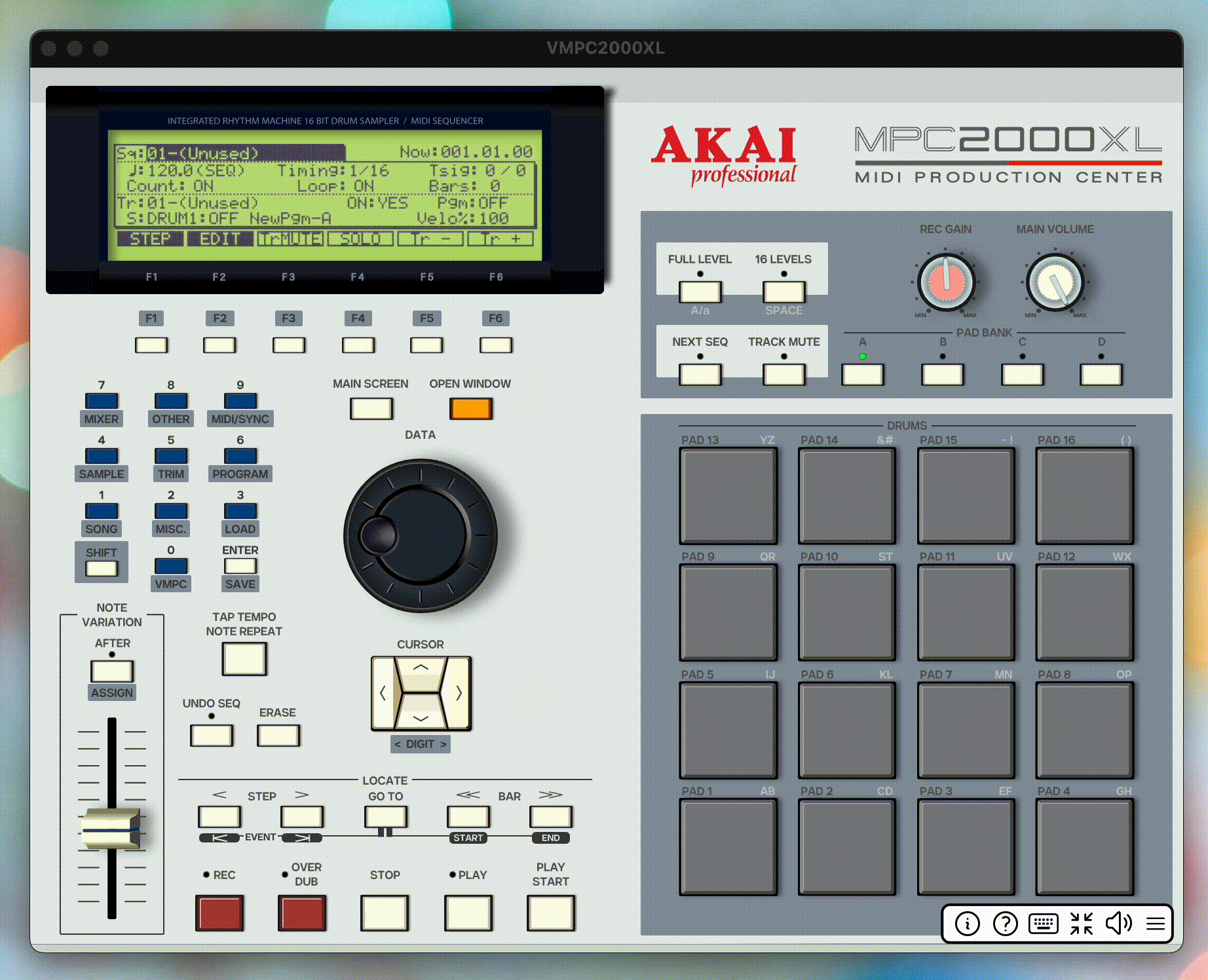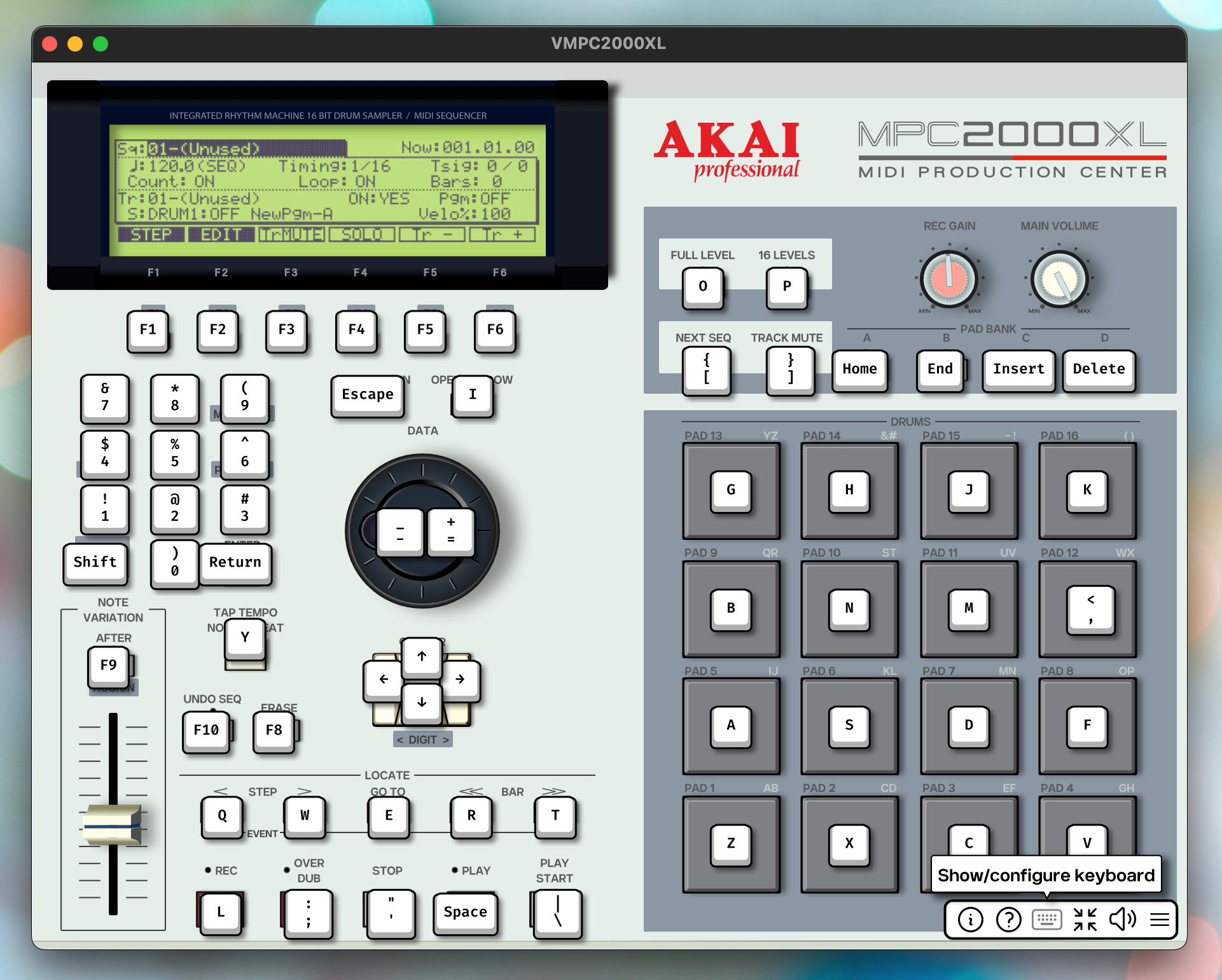Controls
There are 3 ways to control VMPC2000XL:
Keyboard
Mouse/touchscreen
MIDI
It is strongly recommended to get familiar with basic keyboard shortcuts rather than relying on the mouse. The more keyboard shortcuts you use, likely the greater the sense of immersion.
Keyboard
For most controls you can display a tooltip that shows you which key on the keyboard is associated with it. In the case of the DATA wheel it’s 2 keys – one for clockwise and one for anti-clockwise.
To display all controls’ keys, hover over the keyboard icon in the bottom-right menu, or, if you’re on iPadOS, you can press the keyboard icon (and release your finger somewhere else if you don’t want to go the KEYBRD screen).
To display just a single control’s key in a tooltip, on systems with a mouse, hover over the control while holding one of the following keys on your keyboard: Shift, Ctrl, Alt/Option, Cmd/Windows/Meta. On iPadOS (and other systems too), double-tap the Shift button, and the next control you tap will show the key tooltip.
It looks like this:

Below are the default keyboard shortcuts for most of the UI components.
Some letter keys are written in uppercase for disambiguation. For example, Record is mapped to the letter L and is written in uppercase to clarify it is not letter i or number 1, so there is no need to press Shift here. Special characters are clarified by appending their name in parentheses, for example ; (semicolon).
Note
The default keyboard mapping is geared towards US keyboard layout, but it’s fully configurable. See Configuring the keyboard for instructions.
Basic operations
Operation |
Key(s) |
|---|---|
Up, Down, Left, Right |
Up/Down/Left/Right |
Data wheel plus |
+ (to the left of the Tab key) |
Data wheel minus |
- (to the left of the Tab key) |
Numeric keypad |
0 … 9 |
Shift |
Left shift |
Record |
L |
Overdub |
; (semicolon) |
Stop |
' (quote) |
Play |
Space |
Play start |
\ (backslash) |
F1 … F6 |
F1 … F6 |
Main screen |
Escape |
Open window |
I |
Hold one modifier – Shift, Ctrl, or Alt/Option – to turn the DATA wheel 10 steps. Hold two modifiers to turn it 100 steps, and hold three to turn it 1000 steps. In the TRIM, LOOP and ZONE screens, the number of steps per combination of modifiers is tailored to the sound length: the longer the sound, the bigger the number of steps.
Pads
g |
h |
j |
k |
b |
n |
m |
, |
a |
s |
d |
f |
z |
x |
c |
v |
Advanced operations
Operation |
Key |
|---|---|
Bank A |
Home |
Bank B |
End |
Bank C |
Insert |
Bank D |
Delete |
Previous step/event |
Q |
Next step/event |
W |
Locate/Go to |
E |
Previous bar/Start |
R |
Next bar/End |
T |
Tap tempo/Note repeat |
Y |
Erase |
F8 |
Full level |
O |
16 levels |
P |
Next seq |
[ |
Track mute |
] |
After/Assign |
F9 |
Undo seq |
F10 |
VMPC-specific operations
Operation |
Key |
|---|---|
Direct-to-disk recorder |
Shift + L |
Mouse & touchscreen
Pads
The pads can be hit by clicking them with the mouse, or, if you have a touchscreen, by touching them. The closer to the top of the pad, the higher the velocity. When a pad is hit, it will light up blue.
DATA wheel
The DATA wheel can be turned by dragging or scrolling. Precise, single-step changes can be performed by holding any of the modifier keys – Shift, Ctrl, or Alt/Option – while dragging.
On iPadOS you can drag the DATA wheel with one finger for precise, single-step changes, or with two fingers for large increments.
Slider/Rec gain/Main volume
These controls can be operated by dragging or scrolling.
Note that, like on the original MPC2000XL, you can use the slider to change many of the values in the TRIM, LOOP and ZONE screens, by holding SHIFT while moving the slider.
Note
If your mouse or touchpad emits momentum/inertia events, VMPC2000XL will process these accordingly. The DATA wheel, slider, record gain and main volume controls will come to a gradual stop.
Show/configure keyboard
Click the “Show/configure keyboard” icon in the bottom-right menu to go to the KEYBRD tab. See Configuring the keyboard for instructions.
The “Show/configure keyboard” button
Hover over this button, or on iPadOS long-press it, to show an overlay with all current keyboard mappings:

MIDI
Read more about MIDI control in the MIDI control mode and MIDI control sections.